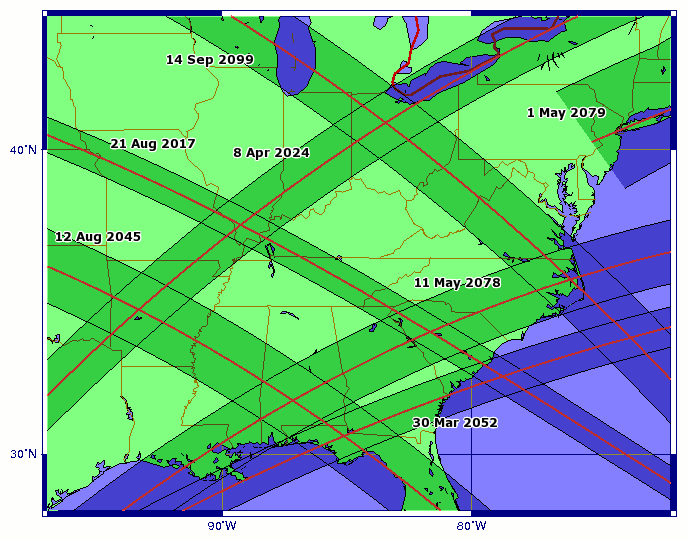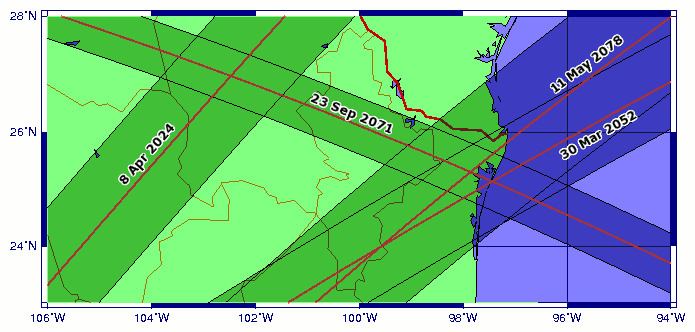As stated in the When section,
solar eclipses occur in complex and unpredictable patterns — for
practical purposes, at "random". On average, though, any given spot on
the Earth's surface will see a total eclipse of the Sun once every 360
years or so. So seeing two total eclipses of the Sun at the same spot
in just 7 years would be fairly remarkable — and seeing four total
eclipses over a small region of the Earth in just 35 years would be
incredible.
However, that's exactly what's going to happen in the middle of the
United States in the first half of the 21st century —
four total eclipses of the Sun will cross a region just 600 miles across,
within the space of 35 years. Two places in the USA will each see
two total eclipses of the Sun separated by just 7 years. And as if
that wasn't enough, just 20 years later it happens again in Mexico,
just over the border from Texas!
Here's a map that shows the action in the south-east USA over the
21st century:
So, in just the next 50 years:
- The centre of
the 21 August, 2017 eclipse passes
close to Carbondale, Illinois; 7 years later, the centre of
the 8 April, 2024 eclipse crosses the same
spot.
- The 2024 eclipse also passes a point
just south of Nimrod Lake, Arkansas; 21 years after that, the centre
of the 12 August, 2045 eclipse crosses the
same point.
- The 2045 eclipse also passes over Altha,
Fl, south-west of Lake Seminole; 7 years later, the total eclipse of
30 March, 2052 crosses the same
spot.
And then it's Mexico's turn for the eclipse bonanza:
- The 2052 eclipse crossed the Laguna Madre area, in Mexico, just 40
miles from Texas, before entering the USA; 19 years later,
the total eclipse of 23 September, 2071 crosses
the same area.
- 7 years later, the centre of
the 11 May, 2078 eclipse crosses the
same Laguna Madre area — and goes on to cross the 2045 and 2017
eclipse paths over the USA. So the same spot in Laguna Madre will see 3
total eclipses of the Sun in 26 years.
This is all just part of an amazing eclipse bonanza which is going
to hit the USA over the next century — a total of 11 total solar eclipses
will be visible from the mainland USA. Hawaii
has no total eclipse of the Sun this century, but will see
an annular eclipse in 2046, and
another in 2100.
The U.S. island territories fare more poorly this century; the only total
eclipse will be visible from Guguan and Alamagan in the Northern Marianas,
which will both see
a total eclipse in 2089, though I
believe they are both uninhabited. Guam and Rota will see
an annular eclipse on 26 Dec, 2019.
U.S. Solar Eclipses
The following chart shows the paths all major
solar eclipses which will be
visible from the USA in this century. Use the
zoom controls on the left to zoom in and out; hover over
the marker in the middle of an eclipse track to see
information on that eclipse. Bear in mind that for
each eclipse shown, a partial eclipse is visible over
a much wider area.
The interactive map is currently not available.
Note that eclipse dates are specified relative to UT.
You have not
selected a timezone for eclipse timings, so all times are shown in UT (
essentially GMT).
21 Aug, 2017 AD
15:46–21:04 UT
Special Site!
Total Solar Eclipse
(umbral mag. 1.03; Saros 145)
eclipse data page
|
A dramatic total eclipse plunged the Sun into darkness for 2 minutes and 40 seconds at maximum, creating an amazing spectacle for observers in a path up to 115 km wide. It was seen across the central US. The partial eclipse was visible from the whole of North America, northern South America, and western Europe and Africa.
|
|
8 Apr, 2024 AD
15:42–20:52 UT
Total Solar Eclipse
(umbral mag. 1.06; Saros 139)
|
A dramatic total eclipse plunged the Sun into darkness for 4 minutes and 28 seconds at maximum, creating an amazing spectacle for observers in a broad path up to 198 km wide. It was seen across north-west Mexico, the U.S. from Texas to Maine, and maritime Canada. The partial eclipse was visible over almost all of North America.
|
|
30 Mar, 2033 AD
15:59–20:02 UT
Total Solar Eclipse
(umbral mag. 1.05; Saros 120)
|
A dramatic total eclipse will plunge the Sun into darkness for 2 minutes and 37 seconds at maximum, creating an amazing spectacle for observers in a very broad path, 781 km wide at maximum. It will be seen in a broad path curving around the Arctic, clipping the far eastern tip of Russia, and taking in north-western Alaska. The partial eclipse will be visible across most of North America.
|
|
23 Aug, 2044 AD
23:09 on 22 Aug–03:21 UT
Total Solar Eclipse
(umbral mag. 1.04; Saros 126)
|
A dramatic total eclipse will plunge the Sun into darkness for 2 minutes and 4 seconds at maximum, creating an amazing spectacle for observers in a very broad path, 453 km wide at maximum. It will be seen in a broad but short path which curves from north-west Greenland, across northern Canada, and down through Alberta to finish in the US states of Montana and North Dakota. The partial eclipse will be visible across north-east Asia and north-west North America.
|
|
12 Aug, 2045 AD
15:05–20:16 UT
Total Solar Eclipse
(umbral mag. 1.08; Saros 136)
|
A dramatic total eclipse will plunge the Sun into darkness for 6 minutes and 6 seconds at maximum, creating an amazing spectacle for observers in a very broad path, 256 km wide at maximum. It will be seen across the central U.S., the eastern Caribbean, and the north-east coast of South America. The partial eclipse will be visible in most of the Americas.
|
|
30 Mar, 2052 AD
15:52–21:07 UT
Total Solar Eclipse
(umbral mag. 1.05; Saros 130)
|
A dramatic total eclipse will plunge the Sun into darkness for 4 minutes and 8 seconds at maximum, creating an amazing spectacle for observers in a broad path up to 164 km wide. It will be seen across Mexico and the south-eastern US. The partial eclipse will be visible across most of North America.
|
|
23 Sep, 2071 AD
14:36–19:59 UT
Total Solar Eclipse
(umbral mag. 1.03; Saros 145)
|
A dramatic total eclipse will plunge the Sun into darkness for 3 minutes and 11 seconds at maximum, creating an amazing spectacle for observers in a path up to 116 km wide. It will be seen across Mexico, the Caribbean, and north-eastern South America. The partial eclipse will be visible over most of the Americas.
|
|
11 May, 2078 AD
15:17–20:31 UT
Total Solar Eclipse
(umbral mag. 1.07; Saros 139)
|
A dramatic total eclipse will plunge the Sun into darkness for 5 minutes and 40 seconds at maximum, creating an amazing spectacle for observers in a broad path up to 232 km wide. It will be seen across Mexico and the south-eastern US. The partial eclipse will be visible over most of North America.
|
|
1 May, 2079 AD
08:39–12:55 UT
Total Solar Eclipse
(umbral mag. 1.05; Saros 149)
|
A dramatic total eclipse will plunge the Sun into darkness for 2 minutes and 55 seconds at maximum, creating an amazing spectacle for observers in a very broad path, 406 km wide at maximum. It will be seen the extreme north-eastern U.S., maritime Canada, and Greenland. The partial eclipse will be visible across north-western Europe and Russia.
|
|
4 Oct, 2089 AD
22:30 on 3 Oct–03:54 UT
Total Solar Eclipse
(umbral mag. 1.03; Saros 145)
|
A dramatic total eclipse will plunge the Sun into darkness for 3 minutes and 14 seconds at maximum, creating an amazing spectacle for observers in a path up to 115 km wide. It will be seen from China, just passing north of Taiwan; the U.S. islands of Alamagan and Guguan; Kiribati; and (barely) Starbuck Island. The partial eclipse will be visible south-east Asia, Indonesia, and Hawaii.
|
|
11 May, 2097 AD
16:18–20:44 UT
Total Solar Eclipse
(umbral mag. 1.05; Saros 149)
|
A dramatic total eclipse will plunge the Sun into darkness for 3 minutes and 10 seconds at maximum, creating an amazing spectacle for observers in a very broad path, 339 km wide at maximum. It will be seen through Alaska and across Svalbard to finish in far northern Lappland. The partial eclipse will be visible over most of Canada, and the northwestern USA.
|
|
14 Sep, 2099 AD
14:22–19:27 UT
Total Solar Eclipse
(umbral mag. 1.07; Saros 136)
|
A dramatic total eclipse will plunge the Sun into darkness for 5 minutes and 18 seconds at maximum, creating an amazing spectacle for observers in a very broad path, 241 km wide at maximum. It will be seen across south-west Canada and the US. The partial eclipse will be visible in most of the Americas and western Africa.
|
|


